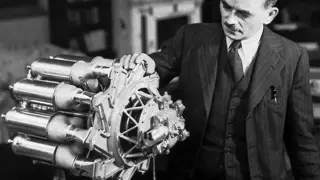
The oldest surviving working example of a Rolls-Royce Welland jet engine is now part of James Dyson's personal collection.
Head in the clouds
By the age of 22, as part of his military training, RAF engineer Frank Whittle had written a game-changing thesis: 'Future Developments in Aircraft Design'. He proposed that aeroplanes fly at higher altitudes, taking advantage of lower air pressure to increase fuel economy and fly faster. Piston-driven and propeller engines weren’t suited to high-altitude flight, so Whittle proposed something revolutionary – a jet engine.
More, with less
By spinning a set of compressor blades at the front, air was forced at high pressure into a combustion chamber. Here it mixed with fuel and burned. The hot exhaust gases were then forced at even-higher pressure out the back. This provided propulsion, driving the compressor at the front, drawing more air in. The new design was more powerful than the piston-driven engines of the day, with fewer moving parts.
Shrinking the world
Whittle's jet engines entered production as the Rolls-Royce Welland, soon finding their way into British fighter aircraft. Shortly after the Second World War's end, the technology was adopted in commercial passenger airliners – allowing them to fly higher, faster and further than ever before. The jet age had started.
